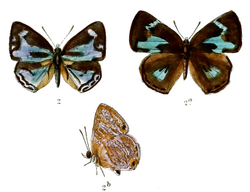Biology:Poritia hewitsoni
| Common gem | |
|---|---|

| |
| Male left, female right | |

| |
| Scientific classification | |
| Domain: | Eukaryota |
| Kingdom: | Animalia |
| Phylum: | Arthropoda |
| Class: | Insecta |
| Order: | Lepidoptera |
| Family: | Lycaenidae |
| Genus: | Poritia |
| Species: | P. hewitsoni
|
| Binomial name | |
| Poritia hewitsoni (Moore, 1865)
| |
Poritia hewitsoni, the common gem, is a small butterfly found in India , Myanmar,[1] Thailand, Malaysia and Vietnam[2] that belongs to the lycaenids or blues family.
Range
It ranges along the Himalayas from Kumaon to Assam in India and onto Myanmar.[1] Recorded from Mangan and Rangpo in Sikkim.[3][4]
Description
It is a small butterfly with a 31 to 38 mm wingspan. Male upper: dark iridescent blue, usually with submarginal and apical spots. The cell on upperside forewing is entirely devoid of blue or with a minute blue spot at the base in some cases. Males also have a tufted brand on the upper hindwing above vein 7. The underside is brown with variable pale lineation. Females: brown above, with a few blue spots. The upper forewing has a yellow discal patch above a blue area.[3][4]
Taxonomy
The butterfly has five subspecies in South Asia:[1]-
- P. hewitsoni hewitsoni Moore, 1865 - Kumaon to Assam and not rare as per Evans,[1] Sikkim to northern Myanmar and northern Thailand[2]
- P. hewitsoni tavoyana Doherty 1889 - Myanmar, not rare[1] Manipur, southern Burma, Thailand, Peninsular Malaya[2]
- P. hewitsoni taleva Corbet, 1940 - Peninsular Malaya[2]
- P. hewitsoni ampsaga Fruhstorfer, 1912 - Vietnam[2]
Habits
The common gem is found flying high in the lowland jungles. The males tend to fly rapidly and settle on leaves.[3] It occurs in Sikkim in October and November. The tufted brand on the male hindwing has a discernible, distinct odour.[4]
Egg
- The egg is truncate, half as long as wide, and with two vertical and sloping and two horizontal faces.[3]
See also
- List of butterflies of India
- List of butterflies of India (Lycaenidae)
Cited references
- ↑ 1.0 1.1 1.2 1.3 1.4 Evans, W.H. (1932). The Identification of Indian Butterflies (2nd ed.). Mumbai, India: Bombay Natural History Society. p. 208, ser no H2.5.
- ↑ 2.0 2.1 2.2 2.3 2.4 "Poritia Moore, [1866]" at Markku Savela's Lepidoptera and some other life forms
- ↑ 3.0 3.1 3.2 3.3 Haribal, Meena (1992). The Butterflies of Sikkim Himalaya and Their Natural History. Gangtok, Sikkim, India: Sikkim Nature Conservation Foundation. pp. 91–92, ser no 106, plate 25 (images of male & female).
- ↑ 4.0 4.1 4.2 Wynter-Blyth, Mark Alexander (1957). Butterflies of the Indian Region. Bombay, India: Bombay Natural History Society. p. 252. ISBN 978-8170192329. https://books.google.com/books?id=yEkgAQAAMAAJ.
References
- Evans, W.H. (1932). The Identification of Indian Butterflies (2nd ed.). Mumbai, India: Bombay Natural History Society.
- Haribal, Meena (1992). The Butterflies of Sikkim Himalaya and Their Natural History. Gangtok, Sikkim, India: Sikkim Nature Conservation Foundation.
- Wynter-Blyth, Mark Alexander (1957). Butterflies of the Indian Region. Bombay, India: Bombay Natural History Society. ISBN 978-8170192329. https://books.google.com/books?id=yEkgAQAAMAAJ.
Online
- Beccaloni, George; Scoble, Malcolm; Kitching, Ian; Simonsen, Thomas; Robinson, Gaden; Pitkin, Brian; Hine, Adrian; Lyal, Chris. "The Global Lepidoptera Names Index (LepIndex)". Natural History Museum, London. http://www.nhm.ac.uk/our-science/data/lepindex/. Retrieved 2016-10-15.
- "Markku Savela's website on Lepidoptera". http://www.nic.funet.fi/pub/sci/bio/life/insecta/lepidoptera/.
Wikidata ☰ Q7230114 entry
 |


